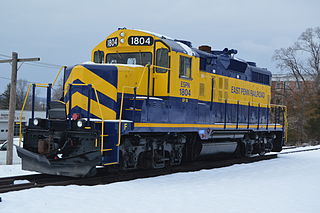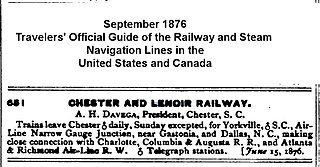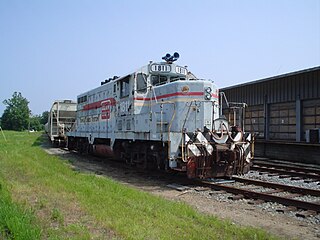Related Research Articles

Catawba County is a county in the U.S. state of North Carolina. As of the 2020 census, the population was 160,610. Its county seat is Newton, and its largest city is Hickory. The county is part of the Hickory–Lenoir–Morganton, NC Metropolitan Statistical Area.

Caldwell County is a county in the U.S. state of North Carolina. It is located in the foothills of the Blue Ridge Mountains. As of the 2020 census, the population was 80,652. Its county seat is Lenoir. Caldwell County is part of the Hickory–Lenoir–Morganton, NC Metropolitan Statistical Area.
The Lancaster and Chester Railroad or L&C is a railway headquartered in Lancaster, South Carolina. The original 29-mile (47 km) route connects Lancaster in Lancaster County with Chester in Chester County. The line's nickname is The Springmaid Line, which refers to its original purpose of connecting the plants of the Springs Mills company.

The Norfolk Southern Railway was the final name of a railroad that ran from Norfolk, Virginia, southwest and west to Charlotte, North Carolina. It was acquired by the Southern Railway in 1974, which merged with the Norfolk and Western Railway in 1982 to form the current Norfolk Southern Railway.

The Northwestern Pacific Railroad is a regional shortline railroad utilizing a 62 mi (100 km) stretch of the 271 mile mainline between Schellville and Windsor with freight and Sonoma–Marin Area Rail Transit (SMART) commuter trains. Formerly, it was a regional railroad primarily used for logging that served the entire North Coast of California, with a main line running 271 miles (436 km) from Schellville to Eureka, along with an additional portion of the line running from the Ignacio Wye to the edge of San Rafael. The "Southern End" of the line, including Schellville to Willits and from Ignacio to San Rafael is owned by SMART, while the "Northern End" was formally owned and managed by the now-dissolved North Coast Railroad Authority but is now saved for use in California's 2018 Great Redwood Trail Act, which repurposes the unused railroad right-of-way from Eureka to Willits for future use as the Great Redwood Trail.
The Virginia Southern Railroad is a shortline railroad division of the North Carolina and Virginia Railroad, a subsidiary of the Genesee & Wyoming, with rights to operate 78 miles (126 km) of track between Norfolk Southern Railway connections at Oxford, North Carolina and Burkeville, Virginia. The southernmost segment between Clarksville, Virginia and Oxford is out of service.
The Lake Tahoe Railway and Transportation Company was a 16-mile (26 km), 3 ft narrow gauge railroad that ran from a connection with the Central Pacific Railway at Truckee, California to the waterfront at Lake Tahoe. The railroad was converted to 4 ft 8+1⁄2 instandard gauge in 1926. The railroad operated its own property from 1899 until October 16, 1925, at which time it was leased to the Southern Pacific Company, which bought the property outright in May 1933. SP abandoned the line in 1943.

The East Tennessee Railway, L.P. is a short line railroad connecting CSX Transportation and the Norfolk Southern Railway in Johnson City, Tennessee. Since 2005, the railroad has been owned by Genesee and Wyoming, an international operator of short line railroads, as part of its Rail Link group. The railroad uses a single diesel locomotive, SW1200 #214, to serve a small number of industries and a transloading facility, as well as to provide interchange services between NS and CSX.
The San Joaquin and Sierra Nevada Railroad was originally built as a 3 ft narrow gauge that ran from Bracks Landing to Woodbridge and Lodi and then east to the Sierra Nevada foothill town of Valley Springs. The railroad was incorporated on March 28, 1882 and construction was completed on April 15, 1885. The railroad was built as a common carrier with copper mining being its primary traffic. The track was built using 35/40 lb steel rails.
The Piedmont & Northern Railway was a heavy electric interurban company operating over two disconnected divisions in North and South Carolina. Tracks spanned 128 miles (206 km) total between the two segments, with the northern division running 24 miles (39 km) from Charlotte, to Gastonia, North Carolina, including a three-mile (5 km) spur to Belmont. The southern division main line ran 89 miles (143 km) from Greenwood to Spartanburg, South Carolina, with a 12 mi (19 km) spur to Anderson. Initially the railroad was electrified at 1500 volts DC, however, much of the electrification was abandoned when dieselisation was completed in 1954.

Standard gauge was favored for railway construction in the United States, although a fairly large narrow-gauge system developed in the Rocky Mountains of Colorado and Utah. Isolated narrow-gauge lines were built in many areas to minimize construction costs for industrial transport or resort access, and some of these lines offered common carrier service. Outside Colorado, these isolated lines evolved into regional narrow-gauge systems in Maine, New York, Pennsylvania, Ohio, Iowa, Hawaii, and Alaska.
Collettsville is a small unincorporated community in Caldwell County, North Carolina, United States. It is part of the Hickory–Lenoir–Morganton Metropolitan Statistical Area.

The Hickory–Lenoir–Morganton Metropolitan Statistical Area, as defined by the United States Census Bureau, is an area consisting of four counties in the Catawba Valley region of western North Carolina. Local residents often refer to the area as the Unifour, although this name is largely unknown outside of the region.

East Penn Railroad is a short-line railroad that operates a number of mostly-unconnected lines in the U.S. states of Pennsylvania and Delaware. Except for two industrial park switching operations, all are former Pennsylvania Railroad or Reading Company lines, abandoned or sold by Conrail or its predecessors.
The Alexander Railroad Company is a Class III shortline railroad operating in North Carolina. The railroad has 18 miles of track that runs northwest from Statesville to Taylorsville, North Carolina.
The Kings Mountain Railroad was a 5 ft gauge shortline railroad that served South Carolina before, during and after the American Civil War.

The Chester and Lenoir Narrow Gauge Railroad was a 3 ft narrow-gauge railroad that served South Carolina following the Civil War.
The Thermal Belt Railway is a Class III shortline railroad that operates for freight service on an irregular schedule on a former CSX line from Bostic to Forest City and on a former Norfolk Southern line from Forest City to Alexander Mills, North Carolina. Total mileage is 8.5 miles (13.7 km). Connections are made with CSX at Bostic. Rail is 85 pounds.

The Caldwell County Railroad is a Class III shortline railroad operating over 17 miles between Hickory and Lenoir, North Carolina. The CWCY is operated by Southeast Shortlines, Inc., which also operates the Thermal Belt Railway.
References
- ↑ Pg. 512; American Narrow Gauge Railroads by George Woodman Hilton; Stanford University Press, 1990
- 1 2 3 4 5 6 7 Tar Heel Press, The Legacy of the Carolina and Northwestern Railway
- ↑ South Carolina Railroads, Kings Mountain Railroad
- ↑ South Carolina Railroads, Chester & Lenoir Narrow Gauge Railroad
- 1 2 South Carolina Railroads/ Carolina & Northwestern Railway
- ↑ Charlotte Observer, Keeping Them on Track, December 29, 2002
- ↑ North Carolina Rail Trails, Vol.2 No. 1; Spring 1990
- ↑ North Carolina Rail Trails, Vol.13 No. 3; Winter 2004
- ↑ Railway Association of North Carolina: Caldwell County Railroad
- ↑ Clearing the Way by Michael Henry; The Gaston Gazette, Friday July 25, 2003